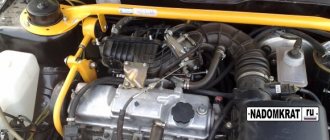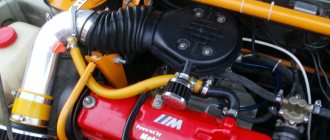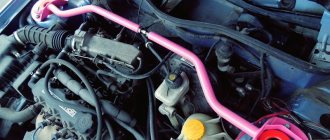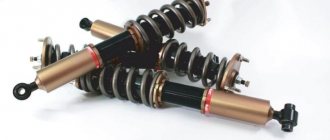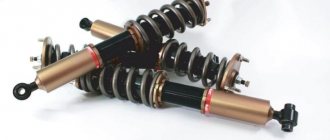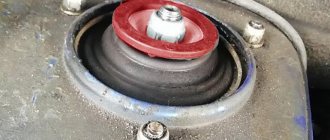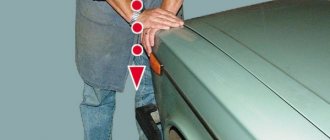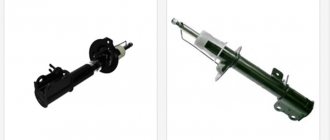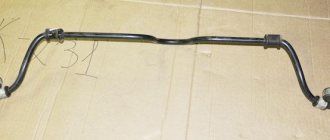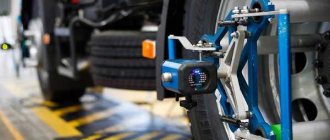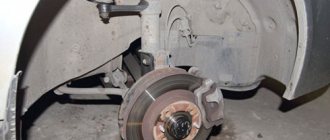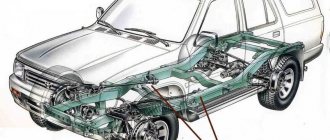Ask any experienced driver with extensive driving experience: why do you need a front strut brace? He will answer without much hesitation. But not every beginner has a complete idea of what it is all about. In addition, for most ordinary car enthusiasts, this element is just some kind of tube, usually yellow in color, nothing more. Some even find it a kind of highlight to show off in front of their friends.
And if you ask them why the front strut is needed, they either don’t know what to answer, or they begin to come up with a completely passable explanation from their point of view. Of course, from the outside it looks unprofessional, and such excuses have nothing to do with the actual purpose. And to understand why this yellow tube is needed, you will have to turn to the structure of the car body.
General overview
The body of any vehicle is assembled from many elements that are connected to each other by welding, bolts, rivets, etc., so if a certain load is applied, they gain some degree of freedom of movement in relation to each other. Most likely, anyone who has gone through extreme driving school knows this firsthand.
And the lower the degree of such freedom, the more integral the body becomes, approaching the state of a single whole. In other words, it becomes more rigid, and the higher this parameter, the better its control. This is especially felt when performing various maneuvers at high speed.
Front strut brace: what is it and why?
Stretching the A-pillars is not only a decorative element of the engine compartment, but also an improvement of the car, tuning its technical part. Thanks to the installation of this element, the rigidity of the body increases.
There is an opinion among car enthusiasts that the body is a solid element. In fact, this is not the case, because it consists of individual parts that are fastened together by welding seams, and in some cases, bolts.
Over time, deformations may occur in the weld areas. This process is observed even in premium segment cars. Most often this occurs due to frequent use of vehicles on uneven asphalt roads and rough terrain. The result of such processes is a decrease in body rigidity. Also, because of this, the car’s handling deteriorates, which in turn can lead to a sad outcome, even an accident. The front strut brace is needed to ensure a safe and comfortable ride.
Modern car production technologies do not provide for a frame body structure. It is made from metal no more than 1 mm thick. For this reason, body deformation increases, which leads to a change in the car's handling for the worse. This process occurs faster if the vehicle is often driven at high speeds.
Some motorists like to “take turns” at high speed. It looks impressive, but the rigidity of the body suffers greatly from this. On a new car such changes will not be noticeable, but after some time the deterioration in rigidity will be very noticeable.
Purpose of stretching the front struts:
- More stable vehicle movement on the highway;
- Improving the quality of control when entering corners;
- Maintaining the integrity and rigidity of the body, regardless of the quality of the road surface on which the car is moving.
The essence of spacers
Now we are gradually approaching the most important thing - the pipe is not at all a way of self-expression in front of others. By and large, this is a technical modification of the vehicle; in another way, it can be called “tuning,” which is pleasant for many car enthusiasts.
A spacer (or guy) is a metal tube with a rectangular or square cross-section. Special platforms are welded to both sides for reliable fastening to a VAZ (“Ten”) car or any other brand.
These elements are usually located in the transverse direction of the engine compartment. The platforms are attached to the rack glasses with bolts from the supports. This allows you to minimize the displacement of parts of the car body relative to each other. In addition to the fact that the installed spacers improve the handling of the vehicle, they are able to take on part of the loads placed on the suspension elements. In turn, this helps to extend the life of the body.
As for cornering, a brace connects the front shock absorber cups into a single unit. As a result, their movement is limited, which gives additional rigidity to the car body.
Purpose of the front strut struts and principle of operation
Why do you need a front strut brace? The car body consists of many elements that are attached to each other using various elements (welding, glue or bolted connections).
That is why, when certain forces are applied to the body, mutual movement of the elements occurs. The fewer such movements, the higher the rigidity, and the better the vehicle's handling. This feature is most noticeable at high speeds when entering a turn.
A strut brace is a part that provides additional rigidity to the car body. Externally, the device looks like a tube with a rectangular or circular cross-section. Special platforms are welded on both sides of the part to ensure the fixation of the lever.
The product is installed across the engine compartment, and the mounting pads are held on the rack cups using bolts already installed on the device. After installation, displacement of the vehicle body is eliminated and, as a result, handling is improved.
Taking into account the above, we can answer why the front strut strut is needed. It takes on part of the loads that are transmitted to the vehicle body. When entering a turn, the spacer prevents the cups of the struts from moving relative to each other, combining them into one whole. As a result, the connected elements of the car’s “box” receive greater rigidity and shift to a lesser extent.
Key Features
To summarize, here are some key points to better understand the role of spacers. When driving on a bad road (potholes, potholes, country roads), rolls, turns, strong loads act on the car body, which deform it. This negatively affects the vehicle's handling, which ultimately leads to a reduction in its service life. And there are reasons for this:
- The weaker the rigidity of the body, the more it will “twist” when entering turns or hitting bumps.
- Metal tends to “get tired” over time, which is why cracks appear in the load-bearing elements.
- The constant impacts that fall on the wheels are also transmitted to the side members of the body. Over time, they begin to bend inward, which can lead to the fact that at one point it will become impossible to adjust the camber of the front wheels.
As a rule, in cars (for example, VAZ “tens”) that have been used in difficult conditions for more than 10 years, the side members are already quite severely deformed.
In this case, it is necessary to use a special stand to stretch them, only after that it is possible, if not necessary, to install the stretch marks.
IS IT WORTH INSTALLING A FRONT STRUT STRETCH ON YOUR CAR?
If driving conditions are not extreme, there is no need to install a brace, but if the suspension is difficult to cope with its functions and is working at the limit, installing a strut should still be done to make cornering more confident. In this case, the risk of skidding is reduced. If the body's lateral load stiffness is low, this procedure will increase the figure by 25%.
On the other hand, increased rigidity can negatively affect the balance and cracks will appear in places where there are sharp changes in rigidity. Also, installing strut extensions on a VAZ 2114 will slightly increase vibrations in the cabin, which passengers can feel. Sometimes car enthusiasts install struts not only for the front, but also for the rear struts, after which the car’s ride becomes stronger and stiffer, and bumps and holes are practically not felt, and handling becomes more harmonious. Such measures are not necessary if the car is used for everyday, quiet driving.
Sources
- nadomkrat.ru/ustroistvo-avtomobiley/hodovaya/rasporka-perednih-stoek-vaz-2114
- zen.yandex.ru/media/id/5e71e20070e1fb013646ac94/rasporka-stoek-na-vaz-teoriia-i-praktika-5e73573820f0dd1f1cae05e0
- luxvaz.ru/vaz-2114/130-rasporka-perednih-stoek.html
- drive2.ru/l/2614079/
Adjustable and non-adjustable stretchers
The non-adjustable spacer is a one-piece piece with no detachable connections. The peculiarity of adjustable stretch marks is that they consist of two units connected by a coupling. Due to this, it becomes possible to change the length of the spacer, making it smaller or larger depending on the need.
Many drivers prefer one-piece structures because they provide a higher degree of rigidity than their adjustable counterparts. However, there may be cases when it is impossible to select a one-piece design for a single vehicle. In this case, adjustable stretch marks are the only correct solution.
Are there any for rear pillars?
In short, yes. And they have no fundamental difference from the front struts. All the same pipes made of light alloys, all the same rings for glasses. The difference may only be in the shape of the bend of the pipe, or it may even be straight.
Unlike the front strut brace, this strut bar has no bends.And what’s more, today enthusiasts install spacers not only on racks, but everywhere else they can:
This number of spacers is usually installed on racing cars
However, such tuning is the lot of racers who do anything for speed. All these parts are made exclusively from carbon fiber to keep their weight to a minimum. The average car enthusiast is unlikely to need such things.
Is it possible to make a strut brace for the front struts yourself? Yes. However, this will require skills in using an angle grinder and a welding machine. If you don’t have duralumin at hand, it doesn’t matter, you can use a regular steel pipe. In the end, it is quite enough for trips around the city and to the country.
What other stretch marks are there?
In addition to non-adjustable and adjustable spacers, there are other types, it all depends on the attachment points of the spacer:
- Two-point - ordinary tubes that are attached to the shock absorber strut cups.
- Three-point – usually this design has the shape of a triangle. Such spacers are attached in the same way as two-point ones, but there is one more point for mounting on the body. Because of this, the rigidity is even higher.
The fact that the 3-point bracing gives a lot of extra rigidity to the body is definitely a plus. However, the large time investment required to install this type of structure is a clear disadvantage.
Preparing for self-production
To make a jumper for the front pillars yourself, you need to prepare the following materials:
- sheet steel with a thickness of at least 3 mm;
- pipe with a diameter of 32-40 mm with a wall thickness of 3 mm or more;
- thin cardboard and marker for making a template;
- primer for metal and paint in an aerosol can.
A thick-walled pipe is what you need to make a guy wire
Regardless of which cross member design you choose - rigid or with hinges, you will not be able to do without a welding inverter, as well as without the skills to work with it. The easiest way is to weld a rigid, non-adjustable spacer, clearly defining all the dimensions. In addition to welding, other tools will be required for the job:
- an angle grinder (in common parlance - a grinder) with a circle for cutting metal;
- electric drill with a set of drills;
- plumbing tools - hammer, core, round file and pliers;
- metal brush;
- spanners;
- measuring devices - tape measure, ruler, square;
- welding gloves and safety glasses.
Required tool kit
Advice. To make a stretcher of the desired shape, which also looks nice in appearance, you will probably need a machine - a pipe bender. Since not every car enthusiast has one, you will have to contact a specialized workshop or bend the pipe manually. To obtain a beautiful turning radius, the metal must be heated.
At the preparatory stage, it is important to decide where in the engine compartment to place the pipe and whether it can be made straight. The jumper should not interfere with vehicle maintenance or block access to the brake system or clutch reservoirs. At the same time, it is necessary to provide a distance of 3-5 cm from the closed hood so that the lid does not rub against the metal of the cross member and mounting flanges.
Advice. When developing the spacer design, keep in mind that the pipe can be moved back or forward within the diameter of the rack cups. It is not allowed to extend it further by welding a long bracket, because in this case forces will act on the flange, tending to rotate it around its own axis.
This is interesting: Car window tinting by spraying - technology
Clear benefits
Car body struts have both their advantages and disadvantages. But perhaps it’s worth starting with something pleasant. The obvious advantages include:
- Due to the increased rigidity of the body, the vehicle corners better.
- Improved car handling is manifested in the fact that it becomes more confident on the road.
- The trajectory when cornering is more precise and clear.
- Less likelihood of age-related cracks appearing on the body.
- Increased machine stability during straight-line movement.
- No deformation when driving over road irregularities.
With regard to cars with high mileage and at least a shorter service life (15 years or more), one thing can be said: after the procedure of retracting the side members (and with such a long history it is necessary to do this in any case), it is recommended to install stretch marks. This is due to the previously mentioned reason – metal “fatigue”. Without proper reinforcement, the car body can quickly become unusable.
Purpose and replacement of front struts
Quite often you can meet motorists who are interested in stretching the front struts on a Lada Priora car. Today, in automobile markets and in auto stores, it is possible to purchase a wide variety of extensions, so-called spacers, for domestic cars.
Most tuning enthusiasts prefer to improve the car with their own hands, but it is worth recalling that currently there are many car services, car dealerships and car repair shops. Therefore, if a car owner values his time, but wants to improve his car, this will not be difficult. Specialists will carry out both high-quality repairs and adjustments.
But what should those who undertake to replace the front strut themselves do? How to change front struts? What are they needed for? Which ones are better? Stretching the front struts of a car is designed to prevent movement of the struts on the front suspension. Due to it, the vehicle's handling is improved, the service life of the body is extended, and the car safety of the Priora is increased. There are two types of struts on Priora:
- three-point;
- point-to-point.
Which ones are better, what is the difference? The difference between them is that the three-point one is attached to three bolts on each side, respectively, the two-point one is attached to two bolts. Without a doubt, the fact remains that the three-point stretch has advantages over the two-point stretch. When choosing a spacer, there are many factors to consider.
For example, if your car has air conditioning and ABS or has an electronic gas pedal, then certain models may not be suitable for you
Before buying a strut, it is very important to study all the intricacies of the car and the strut, because now they will have to complement each other
Guys are made from aluminum or steel. Most automotive experts believe that it is better to choose aluminum, since in the event of a possible road accident, such a spacer will simply break and will not damage the struts.
Step-by-step installation of a stretcher.
- Replacing the front braces begins with unscrewing the screws from the shock absorber struts. Next you need to remove the washers.
- If a motion sensor is installed on any rack in the car, you need to remove it, remembering the location.
- Next, you need to fix the bracket with the sensor under the spacer plate itself so that after installation it is in its usual position.
- After this, a stretcher is installed on the supports. Fits on stiletto heels. It is necessary to begin all actions on the right, then move to the left side.
- Tighten the screws on the rack supports.
A number of disadvantages
Unfortunately, there are also some drawbacks, and now let’s look at a number of disadvantages. All extreme driving school graduates are well aware of them. The negative sides are:
- Under the influence of the load on one wheel, the second one is also affected. Fortunately, modern designs have special notches that allow the part itself to bend, leaving the other wheel intact.
- Some drivers note that after installing the spacers, both struts are damaged. This drawback is quite controversial, but it is still worth considering this possibility.
- Due to stretching on some car models, it may be difficult to change the brake fluid.
- In the event of an emergency or an impact on only one side, the entire front part of the vehicle body is affected.
A natural question may arise: why, for example, are there no front strut struts on the VAZ-2110 from the factory? This is not done for reasons of economy, as it might seem at first glance. It's all about the need to improve the safety of the driver and passengers, because the cars are designed for the mass market.
In addition, studies have shown that cars with stretch marks receive much more serious damage than vehicles without them. We can conclude that in the first case the driver and his passengers are in greater danger.
Varieties
Most often, 2 types of spacers are used for tuning - adjustable and non-adjustable. In practice, it turned out that a spacer with a control mechanism is worse than without it because it consists of 2 parts. Such a spacer will not bring much benefit after installation and will not achieve the desired success.
There are also differences in fastenings. The most commonly used spacers are 2-hole and 3-hole spacers for installation. The hardware with 3 mounting points will last the longest, but to install it, sometimes it is necessary to drill holes in the body. It is also worth noting that its installation is more complicated.
Non-adjustable strut extensions are mainly made for a specific car model. Adjustable ones are most often universal; they can be installed in any car, even if the holes do not fit.
Spacers also differ in the manufacturing method. Some of them are made from solid material using hot stamping technology. There are also spacers consisting of previously manufactured parts that are connected by welding. The first option is more reliable, but the second can also bring a lot of benefits after installation, increasing the rigidity of the body.
Some car owners increase the rigidity of the body by installing rear strut struts, but this option is not common, since the part reduces the free space in the trunk, which is often not enough.
Driving on uneven or dirt roads
In addition to the above advantages, it is worth considering the behavior of the car when driving on uneven roads, as well as when cornering. Let's start with the peculiarities of moving on uneven terrain: in this case, the wheels are constantly subjected to heavy loads.
Here is another argument for those who doubt the question of why the front strut strut is needed: as the speed of the vehicle increases, the impact force will also increase. Because of this, the lower suspension arms suffer, which can lead to their deformation. Thanks to the installed spacer, shocks are absorbed by it. As a result, part of the load is removed from the main suspension elements, which helps protect them from harmful effects.
Pros and cons of front strut braces
Initially, spacers were mounted on sports cars that were used in harsh conditions. In a “reinforced” car you could jump, drive on a bad road and not worry about the safety of the body. At the same time, the steering wheel became more sensitive, which made the control process easier for the driver. In other words, installing front strut braces made the car more durable and stable on the road.
Pros:
- Reducing body deformation to a minimum when entering a turn, as well as when moving off-road. As a result, the risk of cracks appearing on the body is reduced to almost zero.
- The steering wheel becomes more sensitive, which makes the car more maneuverable.
- Improving machine stability during straight-line movement.
Minuses:
- With a strong impact on the side of the body, the vibration is transmitted to the rack on the other side. As a result, both nodes are deformed.
- It takes a lot of money to purchase a device and install it.
- The process of servicing the brake system becomes more complicated - additional obstacles appear when gaining access to the reservoir (adding brake fluid becomes inconvenient).
Due to the curvature of the front struts, the 2-point elements have to be replaced more often. Knowing the advantages and disadvantages of installing the device, you can decide whether the part is needed on your car or not.
Entering a turn
What happens to a car when it turns? Most of the weight of the body is transferred to the side opposite to the turn; excessive roll occurs, which can lead the vehicle away from the given trajectory.
Usually the anti-roll bar should combat this. And yet, why do you need a front strut strut, if there is a stabilizer, which is equipped with all cars without exception. The fact is that such an important part is not always able to withstand lateral loads. With the front struts stretched, it is noticeably easier for the stabilizer to perform its functions.
Let's give an example: if earlier, before the car went through a turn, it was necessary to reduce the speed to 60 km/h each time, then with installed stretch marks this parameter can be safely increased to 80 km/h.
Disadvantages of stretching the front struts
1, On any forum you can come across a similar phrase: in the event of a side impact, the spacer violates the geometry of the opposite part, as a result, not one, but two sides will have to be restored. 2. The spacer makes it difficult to control and add brake fluid, but the problem is solved by installing a front strut spacer from Priora.
Conclusion Whether to install a strut brace or not is a personal matter. We can only say with confidence that if you are going to make a “sports car” out of a VAZ that will constantly receive loads, then there is a need for a spacer. But in this case, it is more correct to approach this issue comprehensively, that is, in addition to the front strut extension, install a rear anti-roll bar as well. Such modifications include the fifth engine mount. By the way, it’s also convenient to dry rags on the spacer.
SOMETHING LIKE THAT
peace to all, catch the photo
Spacer Installation Procedure
To install spacers, it is not necessary to contact specialized service centers. You can do all the work yourself, except if necessary, enlist the support of loved ones. If the vehicle owner does not have the slightest idea about struts and braces, then it is better to visit the nearest service station to install front strut struts.
But if you have confidence in your abilities, then the following algorithm of actions will be useful:
- Place the car on a flat surface.
- Unscrew the nuts from both shock absorber strut cups.
- Washers are installed on the studs or bolts.
- The spacer is put on - the part suitable for the car will fall into place without any effort.
- Tighten and tighten the nuts. If the installed stretcher is of an adjustable type, its position should be adjusted.
There should no longer be any doubt about why the front strut strut is needed, and there is no doubt about the benefits of such an element. At the same time, most car enthusiasts are not ready to donate their funds to purchase factory blanks, preferring to make such a part themselves.
From a theoretical point of view, this is feasible, but it should be understood that the process is no less expensive and complex. This requires skills in working with a lathe and experience as a welder, but who can guarantee the quality of a homemade design?!
Making a spacer with your own hands
The first thing to do is to make flanges. To do this, unscrew the nuts securing the stands to the glasses and, placing cardboard on them, mark the future holes with a marker. Then cut them out in paper and put it on the pins. Now all that remains is to outline the outline of the flange according to the shape of the glass and trim off the excess cardboard. Inside the template, make a round opening corresponding to the protruding part of the support.
Ready cardboard template with holes
Important point. Make the outer edge of the template facing the engine not round, but straight, since a rib for attaching the pipe will be welded to it.
Perform further operations in this order:
- Attach the cardboard template to the sheet of metal, outline it with a marker and cut out the steel flange using a grinder. Round all edges and sand to ensure there are no burrs.
- Mark the centers of the holes and drill them according to the diameter of the studs. Use a small drill first and then a large one. Bevel both sides of the holes and try the part in place. If a discrepancy is found, widen each hole slightly with a round file.
- Cut a 4cm wide strip of steel and weld it at a 90° angle to the straight edge of the flange. To prevent the strip from bending back under pressure from the pipe, make triangular stiffening ribs and weld them along the edges.
- Place the flanges on the studs and check for distortions. Press them with two nuts and carefully measure the distance between the strips to cut the pipe as accurately as possible.
- Disconnect the battery and cover the engine compartment with a damp cloth. Attach a pipe cut to size to the flange brackets and securely weld it at both ends. Check the gap between the hood cover and your structure.
- Unscrew the nuts and remove the brace from the car. Boil all the seams thoroughly, remove the slag and try to put it back. If the structure has been welded so badly that the flanges do not fit on the studs, file the holes again.
- Remove the finished spacer again, clean it with a brush from rust, degrease it and paint it in 2 layers, after applying a primer. Place the jumper in place and finally tighten it with nuts.
Advice. If you plan to bend the spacer, do it before cutting the pipe to size.
The coupling for regulation is placed in the pipe gap
If you are a specialist in welding, then you can easily make the stretch adjustable. To do this, buy a ready-made threaded coupling of the required diameter and weld it in the middle of the cross member, having previously cut it into 2 parts. After welding, twist them together, secure the coupling with a locknut, and only then cut the pipe exactly to size between the flanges.
Note. The described method is quite suitable for making a back stretcher, if you want to do it yourself. In this case, think carefully about the design so that the jumper takes up minimal space in the luggage compartment and does not block it in the middle.
Successful design of the stretcher - it stands right behind the seats
How to make a spread with your own hands - photo
A workpiece cut from metal The workpiece must be rounded and cleaned The part is tried on in place Strips and stiffeners are welded to the homemade flange The pipe must be carefully grabbed to the flange Correct design - the pipe goes around the tank with liquid After painting, the spacer is finally attached To distribute the load, a gusset must be welded to the pipe Last fitting spacers before painting First you need to unscrew the fastening nuts
Bottom line
That's all there is to say about the A-pillar struts. Whether to install them or not is an individual decision for everyone. Such tuning by itself is ineffective. To fully improve your car, you will need a comprehensive approach.
Before installation, you should strongly consider and analyze your driving style and character. Is she aggressive? Perhaps you can do without additional supports and struts, preferring a quiet ride on your vehicle. In addition, it makes sense to install such a part if the car is fairly used. Such tuning will extend its life, improve maneuverability when cornering and prevent body deformations.
What is the front strut brace on a VAZ 2114? This is a power element that is part of the body structure. Its task is to reduce the loads placed on the body if the shock absorbers are not doing their job. Additionally, the spacer allows you to avoid deformation of the corners after wheel alignment, increase vehicle controllability, and improve its stability on the road.
In the end, we are talking about an element of safety and a means of increasing the life of the body of your car.
Today we will look at the spacers for the front pillars in more detail, we will study their tasks, the nuances of selection and installation on the VAZ 2114.
Why install
In fact, the body of the VAZ 2114 is quite rigid, so it allows you to drive at decent speeds on roads that are not of the highest quality. But the existing rigidity is not enough to keep the body intact during long-term use in such conditions.
If the stiffness is insufficient, the car's handling is characterized by sluggish response. In theory, the presence of a spacer or extension allows you to maneuver more confidently and take turns at speed. Also, the body will not be greatly deformed, and the effect of metal fatigue will be avoided. This is especially true for owners of the VAZ 2114, who regularly drive on roads that are not of the highest class.
To summarize, let's look at what exactly spacers will do.
- They will increase the car's controllability when cornering.
- They will reduce the likelihood of spontaneous transmission shutdown at the gearbox.
- They will protect the engine from active displacements during maneuvering.
- Maintains the integrity of the body and power unit.
Some note that it is not worth installing a spacer, since it significantly increases the noise level in the cabin. The statement is true, but partially. The noise level will indeed increase, but only slightly. In practice, it is impossible to feel the difference, since the increase will be no more than 0.5 decibels.
For reference, specially trained people are able to distinguish noise levels only starting from 1 decibel.
Human factor (feelings before and after installation of the stretcher)
At low speeds and maneuvers, changes in sensations are practically reduced to zero, and this is also, of course, elementary physics, since the ability of the forces influencing the power points in this case is minimal due to the uniform and moderate influence. At higher speeds and maneuvering, the car rolls less when turning, the steering is more clearly responsive and, accordingly, the overall impression is that the car has become more reliable, strong and composed.
Now we can only hope that this article will help you with choosing the right decision regarding whether to install a spacer
to your car.
Very often, for those who like to drive a VAZ, you can see a spacer under the hood, usually yellow. Attitudes towards such modifications are quite varied. Some say that this is a very necessary thing, others say that such a spacer does more harm than good. So, in this article I want to list all the pros and cons of stretching the front struts. And also how to install a spacer on a VAZ 2110 with your own hands.
- The car behaves more stable at high speeds when cornering.
- Road unevenness causes less deformation of the car body.
- Reducing extraneous noise and crackling of the interior trim.
- Steering wheel vibration becomes less.
- The body becomes more rigid.
- Beneficial effect on front suspension parts.
There is no evidence of these disadvantages, well, at least not known to me, so it’s up to you whether to believe them or not. There is an opinion that in an accident, namely in a side impact, not only the side of the impact will suffer, but also the other side (it will bend the bowl, the stand). You say, exactly, this will happen with the help of a spacer, but these spacers have a hole in the center, through which, during an impact, the spacer bends and it does not transfer the blow to the other side. Another legend says that during a frontal impact, the engine is carried into the cabin due to the strut. Honestly, it seems to me that this is not justified and the spacer certainly cannot affect this. Therefore, I repeat once again, the choice is yours to trust these legends or not.
The only negative that I heard about from owners of cars with installed spacers is that on some cars it slightly interferes with adding brake fluid.
There are 2 types of such stretch marks: adjustable and solid. I advise you to use adjustable ones only if none of the solid ones fit your car. Or, over time, the bowls have collapsed inward (this happens over time, they shrink by 4-10 mm) and the solid spacer just doesn’t work.
According to the type of fastenings, spacers are also divided into 2 types: two-point and three-point. The first ones are attached only to the studs of the glass, the second ones have another fastening - to the body.
- First of all, unscrew the nuts on the strut supports (don’t worry, the strut won’t run away).
- We put the spacer on the support bolts. It happens that the holes almost coincide (Ravshan and Dzhumshut made the spacer), then use a drill to drill out the holes. If you are using an adjustable spacer, use the adjusting nut to adjust the distance between the supports.
- Tighten the nuts on the strut supports.
Every motorist wants to improve and improve the characteristics of his “iron horse” by equipping, supplementing and tuning it. Many people add all kinds of struts to their vehicles.
For most people, the front brace is just a way to show off to friends or acquaintances. Few people know its true value and purpose. In this article you can find out what a front strut brace is, why it is needed and what advantages/disadvantages it has.
Maintenance and testing of the front suspension of VAZ 2113-2114-2115
Maintenance and checking the suspension for damage.
During each maintenance, as well as during repairs, you should always check the condition of the protective covers of the suspension ball joints, paying special attention to the absence of mechanical damage to the covers. Find out if there are any cracks or traces of contact with road obstacles or the body on the suspension parts, deformations of the transverse arms, braces, stabilizer bar and its struts and parts of the front body in the places where the suspension units and parts are attached
Deformation of the suspension parts of the Lada Samara 2 and, above all, the braces and parts of the front body of the body violates the wheel alignment angles and makes it impossible to adjust them
Find out if there are any cracks or traces of contact with road obstacles or the body on the suspension parts, deformations of the transverse arms, braces, stabilizer bar and its struts and body front parts in the places where the suspension units and parts are attached. Deformation of the Lada Samara 2 suspension parts and, above all, the braces and front body parts disrupts the wheel alignment angles and makes it impossible to adjust them.
Check the condition of the rubber-metal joints, rubber cushions, suspension ball joints, as well as the condition of the upper supports of the telescopic suspension struts.
Rubber-metal hinges of the VAZ 2113, rubber cushions and the upper supports of the telescopic racks of the VAZ 2114 must be replaced in case of ruptures and one-sided “bulging” of the rubber and when their end surfaces are cut.
Front suspension assembly 1 – upper support of telescopic strut 2 – upper support cup 3 – compression stroke buffer with protective casing 4 – compression buffer support 5 – suspension spring 6 – lower spring support cup 7 – steering rod ball joint 8 – steering knuckle 9 – telescopic strut 10 – eccentric washer 11 – adjusting bolt 12 – strut bracket 13 – steering knuckle 14 – front brake protective cover 15 – brake disc 16 – lock ring 17 – wheel hub nut 18 – splined shank of the wheel drive joint housing 19 – guide pin 20 – wheel hub bearing 21 – ball joint 22 – suspension arm 23 – shims 24 – stabilizer bar 25 – stabilizer bar 26 – stabilizer bar cushion 27 – stabilizer bar mounting bracket 28 – body bracket for mounting the suspension arm 29 – suspension arm extension 30 – brace mounting bracket 31 – ball pin protective cover 32 – ball pin bearing 33 – ball pin 34 – ball pin housing 35 – suspension strut rod 36 – outer housing of the upper support 37 – inner housing of the upper support 38 – bearing of the upper support 39 – rubber element upper support 40 – travel limiter of the upper support 41 – protective cap of the upper support B – area for checking the suspension hinge
To check the condition of the suspension ball joint, remove the wheel and measure the distance between the lower arm 22 and the protective casing 14 in zone B. If, when the suspension is rocked, this distance changes by more than 0.8 mm, replace the ball joint. A more precise check of the ball joint is described in the chapter “Checking the technical condition”.
To measure the gap in the ball joint on a VAZ 2115, use tool 02.7834.9503.
